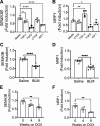SEMA3B inhibits TGFβ-induced extracellular matrix protein production and its reduced levels are associated with a decline in lung function in IPF
- PMID: 38646784
- PMCID: PMC11371361
- DOI: 10.1152/ajpcell.00681.2023
SEMA3B inhibits TGFβ-induced extracellular matrix protein production and its reduced levels are associated with a decline in lung function in IPF
Abstract
Idiopathic pulmonary fibrosis (IPF) is marked by the activation of fibroblasts, leading to excessive production and deposition of extracellular matrix (ECM) within the lung parenchyma. Despite the pivotal role of ECM overexpression in IPF, potential negative regulators of ECM production in fibroblasts have yet to be identified. Semaphorin class 3B (SEMA3B), a secreted protein highly expressed in lung tissues, has established roles in axonal guidance and tumor suppression. However, the role of SEMA3B in ECM production by fibroblasts in the pathogenesis of IPF remains unexplored. Here, we show the downregulation of SEMA3B and its cognate binding receptor, neuropilin 1 (NRP1), in IPF lungs compared with healthy controls. Notably, the reduced expression of SEMA3B and NRP1 is associated with a decline in lung function in IPF. The downregulation of SEMA3B and NRP1 transcripts was validated in the lung tissues of patients with IPF, and two alternative mouse models of pulmonary fibrosis. In addition, we show that transforming growth factor-β (TGFβ) functions as a negative regulator of SEMA3B and NRP1 expression in lung fibroblasts. Furthermore, we demonstrate the antifibrotic effects of SEMA3B against TGFβ-induced ECM production in IPF lung fibroblasts. Overall, our findings uncovered a novel role of SEMA3B in the pathogenesis of pulmonary fibrosis and provided novel insights into modulating the SEMA3B-NRP1 axis to attenuate pulmonary fibrosis.NEW & NOTEWORTHY The excessive production and secretion of collagens and other extracellular matrix proteins by fibroblasts lead to the scarring of the lung in severe fibrotic lung diseases. This study unveils an antifibrotic role for semaphorin class 3B (SEMA3B) in the pathogenesis of idiopathic pulmonary fibrosis. SEMA3B functions as an inhibitor of transforming growth factor-β-driven fibroblast activation and reduced levels of SEMA3B and its receptor, neuropilin 1, are associated with decreased lung function in idiopathic pulmonary fibrosis.
Keywords: SEMA3B; TGFβ; extracellular matrix; fibroblasts; pulmonary fibrosis.
Conflict of interest statement
A.G.J. is a member of the Scientific Advisory Board of Gen1E Lifesciences. The other authors declare no conflicts of interest.
Figures






Similar articles
-
Human antigen R promotes lung fibroblast differentiation to myofibroblasts and increases extracellular matrix production.J Cell Physiol. 2021 Oct;236(10):6836-6851. doi: 10.1002/jcp.30380. Epub 2021 Apr 14. J Cell Physiol. 2021. PMID: 33855709 Free PMC article.
-
Semaphorin 3E-Plexin D1 Axis Drives Lung Fibrosis through ErbB2-Mediated Fibroblast Activation.Adv Sci (Weinh). 2025 May;12(18):e2415007. doi: 10.1002/advs.202415007. Epub 2025 Mar 20. Adv Sci (Weinh). 2025. PMID: 40112179 Free PMC article.
-
Endogenous Semaphorin-7A Impedes Human Lung Fibroblast Differentiation.PLoS One. 2017 Jan 17;12(1):e0170207. doi: 10.1371/journal.pone.0170207. eCollection 2017. PLoS One. 2017. PMID: 28095470 Free PMC article.
-
CTHRC1: An Emerging Hallmark of Pathogenic Fibroblasts in Lung Fibrosis.Cells. 2024 May 30;13(11):946. doi: 10.3390/cells13110946. Cells. 2024. PMID: 38891078 Free PMC article. Review.
-
Lung Fibroblasts, Aging, and Idiopathic Pulmonary Fibrosis.Ann Am Thorac Soc. 2016 Dec;13 Suppl 5:S417-S421. doi: 10.1513/AnnalsATS.201605-341AW. Ann Am Thorac Soc. 2016. PMID: 28005427 Review.
Cited by
-
Vitamin D Attenuates Fibrotic Properties of Fibrous Dysplasia-Derived Cells for the Transit towards Osteocytic Phenotype.Int J Mol Sci. 2024 May 1;25(9):4954. doi: 10.3390/ijms25094954. Int J Mol Sci. 2024. PMID: 38732172 Free PMC article.
-
SEMA3B switches axon-axon to axon-glia interactions required for unmyelinated axon envelopment and integrity.Nat Commun. 2025 Jul 1;16(1):5433. doi: 10.1038/s41467-025-61318-8. Nat Commun. 2025. PMID: 40595635 Free PMC article.
References
Publication types
MeSH terms
Substances
Grants and funding
LinkOut - more resources
Full Text Sources
Molecular Biology Databases
Miscellaneous

